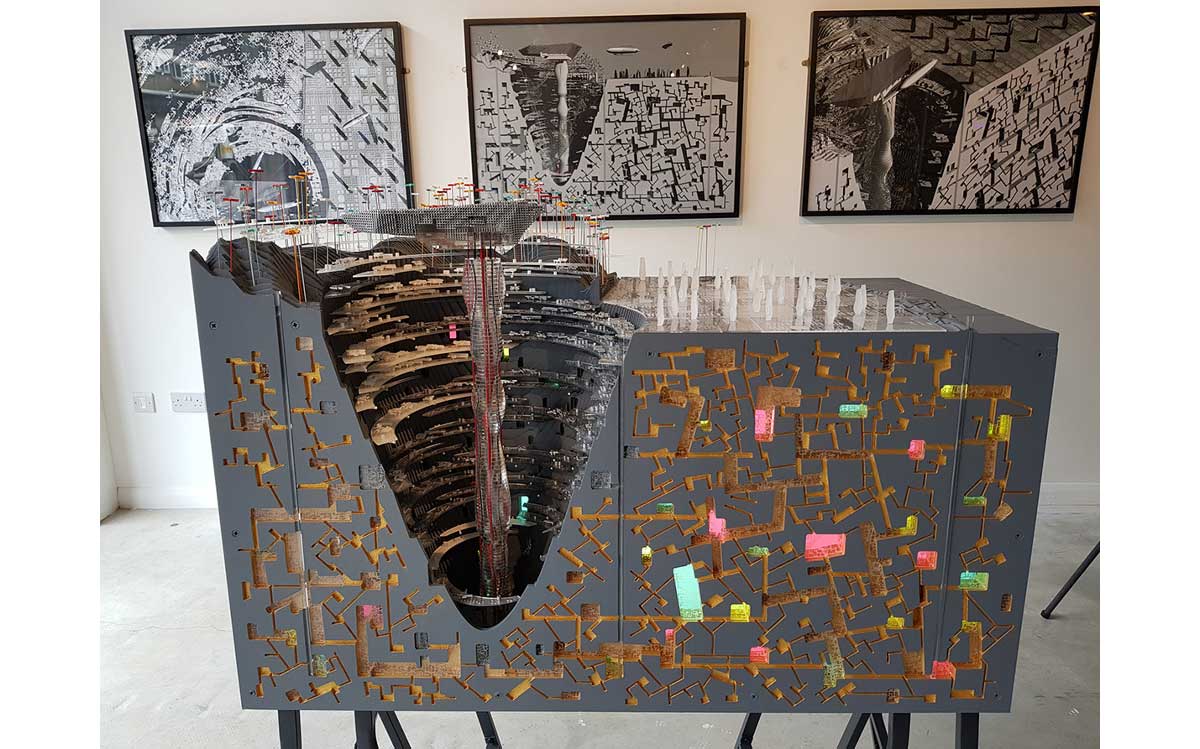Professor Nic Clear
Head of Architecture and 3D Design
Professor Nic Clear’s underground city for three million people is on display as part of the Royal Academy’s Summer Exhibition. The model, entitled Chthonopolis, is Professor Clear’s vision of the future – an underground city for three million people, whose homes are built by droids from modified salt and their diet is based on insect protein.
VISITORS to one of the world’s most popular annual art exhibitions have been intrigued by a University of Huddersfield professor’s vision of the future – an underground city for three million people. Their homes are built by droids from modified salt and their diet is based on insect protein.
Nic Clear insists that his large architectural model, which is on display at the Royal Academy as part of its famous Summer Exhibition, running until 19 August, is an optimistic interpretation of things to come.
“It is a utopia. I am fed up with a dystopian notion of the future. I am someone who believes in improvements through technological progress,” said Professor Clear, who came to the University of Huddersfield at the start of 2018 to head the Department of Architecture and 3D Design.
“One of my main research threads is architecture as science fiction and like certain sci-fi authors I am assuming a series of technological advances and how architecture might respond.”
The model that he is exhibiting at the Royal Academy is titled Chthonopolis, meaning underground city. It is installed in the same room as works by some of the biggest names in contemporary architecture, such as Lord Rogers, Lord Foster and Thomas Heatherwick.
Professor Clear – himself a leading figure in the use of digital technology and animation in the development and production of architecture – is a previous exhibitor at the Royal Academy. “It’s a great showcase for architectural projects. It’s curated and it’s an international exhibition that exposes your work to a huge audience,” he said.
Surrealism in Architecture
 Professor Nic Clear's model of an underground city, entitled Chthonopolis
Professor Nic Clear's model of an underground city, entitled ChthonopolisThe project that led to Chthonopolis, which is featured in 2018 book Celebrating the Marvellous: Surrealism in Architecture, began in 2014 when Professor Clear was asked to exhibit at a World Science Fiction Convention in London.
“The research team that I led built a very big model of a futuristic city at Canvey Island in Essex – near where I grew up – and at the centre of it was a caldera in which a series of labyrinths were created.”
Professor Clear draws on a wide range of influences, including sci-fi – he wrote the architecture section in the Oxford Handbook of Science Fiction – and computer games as well as other architectural visionaries. He has a chapter in the 2014 book Future Details of Architecture and in this he explores some of the logistics of his underground city, such as its materials, methods of construction and food sources – including genetically-grown insect protein.
The structures in the kilometre-wide and kilometre-deep city represented in Chthonopolis would be made from a nano-modified form of sodium chloride, with robotic droids doing the building work.
In his teaching at the University of Huddersfield, Professor Clear encourages students to take a more speculative approach to their architectural projects and he believes that by ensuring that they have a sophisticated skillset – including animation – they will be more ambitious and more employable.
“One of the most dangerous things that a student can do is to play it safe and think that all they should be leaving university with is the skills that employers already need.
“A lot of practices employ my students because not only have they the conventional drafting, technical and professional skills, but they are also able to do something – such as animation – for which practices otherwise have to look externally.”
- Examples of the work by students of Professor Clear dating back to 1999 can be found at http://unitfifteen-archive.com.
More Stories
Leading roles for Head of the GDRC
Professor Dilanthi Amaratunga’s international reputation in Disaster Risk Reduction has led to a number of major appointments
Building occupancy behaviour effects energy usage
PhD researcher Rima Alaaeddine was selected to present her research at Westminster
International Conference on Building Resilience
University’s Global Disaster Resilience Centre chair 7th international conference in Bangkok
